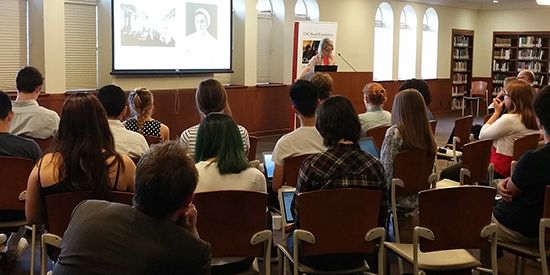Wendy Lower, 2015 Yom HaShoah Scholar, Exposes German Women's Role in Holocaust

Professor Wendy Lower began her 2015 Yom HaShoah Lecture on Thursday by admitting that, like many scholars, she found her research topic by accident.
In 1992, she was a PhD candidate at American University on a research trip to Ukraine. At the time, Holocaust scholars were mainly interested in researching the decision-making behind the Holocaust – how Adolf Hitler and other top Nazis actually directed the Final Solution to take place. So, Lower, too, was looking for key documents at archives in Ukraine that might shed light on this question.
She didn’t end up finding the crucial materials she was looking for, but she did find something else: personnel lists showing that a significant number of young German women were stationed in Ukraine during World War II. As she began digging further, she found countless other files indicating that women did indeed play active roles in the German war effort in a variety of ways.
Lower said that this raised the question in her mind of why German women’s roles in the Holocaust had never been truly exposed or discussed before. Most depictions of German women during the Holocaust were “caricatures,” Lower said: either they were demure housewives whose only job was to produce Aryan babies, or they were fanatics, screaming and waving flags at Hitler rallies. Lower set out to create a more realistic portrait of these women, one that is just as nuanced and detailed as the study of male Nazis, and discover how women got involved in the war effort, why, and what they did.
She has performed her research with the help of USC Shoah Foundation’s Visual History Archive. Lower said that the testimonies have enabled her to add victims’ and survivors’ voices into her research, particularly to provide context for historical photographs.
Her project has taken shape as the book Hitler’s Furies: German Women in the Nazi Killing Fields, which focuses on 13 women who represent a “spectrum” of how women participated in the Nazi party during World War II. In her lecture, Lower told the stories of three women featured in the book.
The first, Erna Petri, was tried and convicted along with her husband for crimes perpetrated during the Holocaust. She admitted to shooting six Jewish children on her farm, and said she did it because she was living surrounded by Nazi officials and had become “hardened” and wanted to prove herself to them.
Another young woman went to Ukraine to work with the German Red Cross, entertaining German soldiers who were stationed on the Eastern front. Lower said that for many young women, going east felt like an adventure and was an opportunity to leave their hometown for the first time in their lives.
Finally, a large number of the women perpetrators were secretaries who performed administrative work for SS commandants. They would maintain lists of Jews who were to be killed, destroy documented evidence of crimes, and control safes that contained secret orders.
Lower explained that these young women were part of a unique generation – a “lost generation.” They were born right after World War I and came of age during the rise of the Nazi Party. They were active politically, but they were not feminists; rather, they became “agents of a conservative, racist revolution.” One photo Lower found in archives depicts the wife of an SS commandant straddling a motorcycle, wearing an apron and with her hair pulled back into a conservative bun: a perfect combination of housewife and radical.
Learning the stories of these women has made it even more important for Lower to further investigate the role of German women in the Holocaust and share these stories with the public so that we can finally view female and male perpetrators and bystanders equally. Other scholars have stated that genocide cannot happen without the broad participation of society, Lower noted.
“And yet nearly all histories of the Holocaust leave out half of the population of that society as if women’s history happened somewhere else,” Lower said. “It is an illogical approach and puzzling omission.”
Women like Erna Petri and her contemporaries reveal the darkest side of female activism, she added.
“They show us what could happen when women are mobilized for war and acquiesce in genocide,” she said.